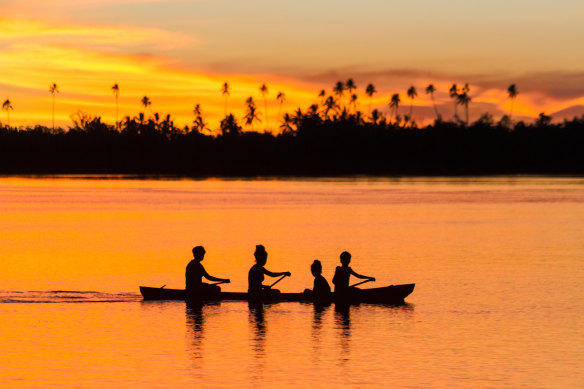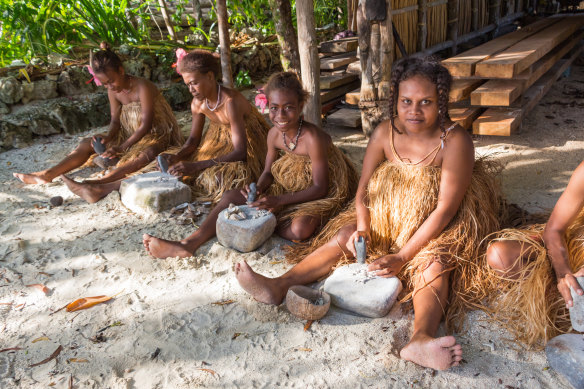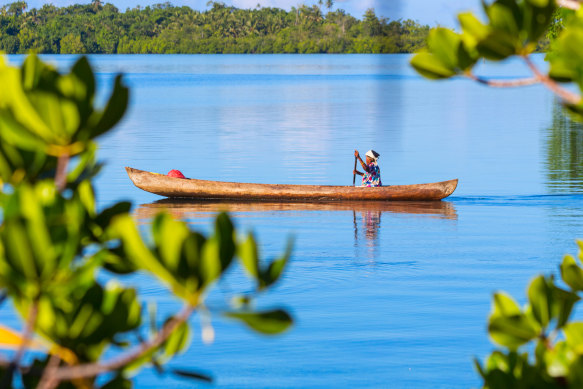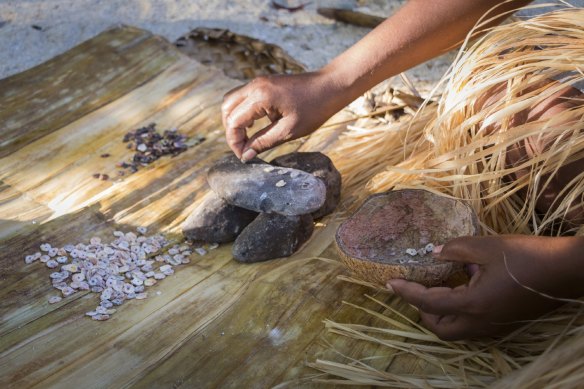The unspoilt tropical island that still uses shell money
By Christine Retschlag
At the Malaita markets, amid the low murmur of mammas, the pungent scent of freshly netted tuna, and plump coconuts plucked straight from the tree, shell necklaces are coiled like king cobras.
I am ambling among the colours and characters of the central market on this remote Solomon island, 50 kilometres northwest of the capital Honiara, where tradition is etched as deeply as tribal tattoos, and ancient shell money holds more value than any paper or plastic.

Dusk on the Langa Langa Lagoon.Credit: Getty Images
Later, onboard a rustic red banana boat, I cruise through Ambu passage and into the tongue twisty Langa Langa Lagoon framed by sugar palm leaf shacks.
To my left, shards of light tussle with stabbing showers over the 900-metre-high Mount Alasa’a – the largest mountain in Malaita, the most populous Solomon island and home of the annual Shell Money Festival.

In remote parts of Malaita Island, shells are still used as a currency. Credit: Getty Images
To my right, and perched over the water, sits Taflabana Guest House, opened 2.5 years ago by Edwin and Hilda Sofaemaena.
Hilda, who still trades in shell money, is determined to keep alive the tradition which can be traced back to this lagoon 16 to 17 generations ago, when the “shell money woman” was banished from neighbouring Papua New Guinea and paddled her canoe into Malaita.
According to local lore, she met a warrior whom she married and who wanted to take her into the bush, but she resisted because there were no shells there. Instead, she settled in the Langa Langa Lagoon.

The tradition of shell money can be traced back to this lagoon 16 to 17 generations ago.Credit: Getty Images
“It is not just any shells, they are special shells and they commuted with our first ancestors who settled in Langa Langa Lagoon. Shell money binds the family unit together,” Hilda says.
“Men do most of the diving and polishing, and there are four types of shell: red (romu), black (kurila), brown (ke-e), and white (kakadu). The most prized one is red; it’s like gold. And they are not just any colours, they all have meaning.
“The red, which is the eagle, is always in the middle of the shell money; black and white represents the sea snake; and the brown is the octopus.”
While paper money is accepted in Malaita, shell money is commonly used for small purchases such as groceries as well as larger, more significant payments such as funerals, settling disputes, or paying for a dowry with the average “bride price” set at around $10,000 Solomon Islands dollars ($1753), and a “virgin” fetching as much as $SBD50,000 in local currency ($8700).
Hilda says Edwin gave “five units of shell money to her maternal uncles” because she was a divorced.
“That’s the benchmark for divorcees or widows if they remarry,” she says. “But deep in his heart he knows I am worth gold.”
Even dignitaries and government officials use shell money, which is growing in popularity all over the Solomon Islands.
“Even today, I go to the shops to buy a bag of rice with it. Families store their shell money in a chest or safe box. To us, it is status to have lots of shell money in a safe box,” Hilda says.
It’s becoming, indirectly, a national symbol, according to the local, while Langa Langa Lagoon is a royal mint for shell money.
“It’s more than just currency. It’s our life – everything revolves around shell money.”
At the Taflabana Guest House, visitors can learn the eight steps to making shell money: breaking shells; shaping; flattening; drilling; heating; threading; smoothing and designing.

Locals keep the tradition alive by demonstrating how to make shell money.Credit: Getty Images
A simple necklace can take as long as three days to make while a typical 2.4-metre-long strand of red money can take between two and three months to complete.
Like the sea snake the black and white shell money represents, shell money is slithering back into the local economy and the Solomons capital.
Back in Honiara’s Chinatown sits a small, baby-blue timber shack. Mary Sifoburi, 33, opened the Shaenkola Shell Money Shop with her three siblings in 2021 to preserve the tradition of her native Malaita.
The shop sells necklaces, bracelets, earrings and decorative costumes, as well as offering a hire service for shell money products. A 2.1-metre-long strand costs about $175 ($SBD1000); 2.4 metres is $192 ($SBD1100); and 3.6 metres is $526 ($SBD3000).
The store sells an average of $SBD7000 ($1227) a week worth of shell money, a figure which increases during festivals and ceremonies.
Mary holds the 3.6-metre-long coil, which weighs between one and two kilograms, in her hands and considers the weight of reviving an ancient tradition.
“We decided to open the shop as we have seen the importance of shell money. The only other place you can buy it is in the central market,” she says.
“It is our identity. It is something that’s passed down from our ancestors. We have to preserve the culture and remind us of where we came from.”
The details
Fly
Malaita is a 45-minute flight from Honiara or a two-hour express ferry ride across Indispensable Strait.
The writer travelled as a guest of Tourism Solomons. See visitsolomons.com.sb
Sign up for the Traveller Deals newsletter
Get exclusive travel deals delivered straight to your inbox. Sign up now.